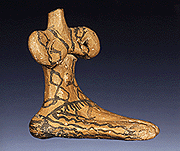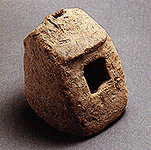 

 |
| Figurine art and house models are the most important forms of artistic
expression of Neolithic man. The depiction of people, animals and objects
in clay, stone, bone, sea-shell, and more rarely in silver and gold, did
not aim at the simple rendering of the main aspects of Neolithic daily
life. The variety of figurines, their large number, the different quality
of manufacture (meticulous or fortuitous) together with their discovery
in settlements but also graves indicates rather that they were creations
with a wide socio-ideological content and had symbolic connotations.
Anthropomorphic and zoomorphic figurines accompanied man at birth, in his daily life (children's toys), and in death. In figurines not only is fertility visualized (figurines of pregnant women, phalloi), but also life (women in childbirth), motherhood, animals being raised. Clay models of houses symbolized the vital core element of the settlement and were used, along with anthropomophic figurines, in symbolic acts as well, such as foundation offerings, recorded at Platia Magoula Zarkou in Thessaly. Figurines were creations either of experienced and well known craftsmen in the Neolithic settlements (e.g. vase makers) or just products of the spontaneous expression of Neolithic man. In the early phases of the Neolithic they were naturalistic, while from the Late Neolithic schematization with abstract features of men and animals predominated. |